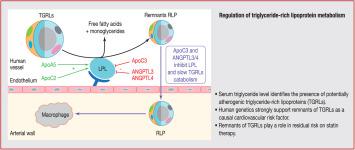Archives of Cardiovascular Diseases ( IF 2.3 ) Pub Date : 2021-02-03 , DOI: 10.1016/j.acvd.2020.11.006 Michel Farnier , Marianne Zeller , David Masson , Yves Cottin

|
Low-density lipoprotein cholesterol is a well-known causal factor for atherosclerotic cardiovascular disease, and is the primary target of lipid-lowering therapy. There is, however, still a substantial risk of atherosclerotic cardiovascular disease events despite intensive statin therapy, and data from clinical trials suggest that an elevated concentration of triglycerides is a marker of residual cardiovascular risk on low-density lipoprotein-lowering therapy. Serum triglycerides are a biomarker for triglyceride-rich lipoproteins, and several lines of evidence indicate that triglyceride-rich lipoproteins and their cholesterol-enriched remnant particles are associated with atherogenesis. Moreover, genetic data in humans strongly suggest that the remnants of triglyceride-rich lipoproteins are a causal cardiovascular risk factor. Although lifestyle changes remain the cornerstone of management of hypertriglyceridaemia, a recent trial with high doses of the omega-3 fatty acid icosapent ethyl showed a significant reduction in cardiovascular events that was not explained by the reduction in triglycerides alone. In patients with elevated triglycerides, several novel drugs are in development to reduce the residual risk on statin therapy linked to an excess of atherogenic triglyceride-rich lipoproteins. In this review, we provide an update on the biology, epidemiology and genetics of triglycerides, and the risk of atherosclerotic cardiovascular disease.
中文翻译:

甘油三酸酯和动脉粥样硬化性心血管疾病的风险:最新动态
低密度脂蛋白胆固醇是动脉粥样硬化性心血管疾病的众所周知的病因,也是降脂治疗的主要目标。然而,尽管进行了他汀类药物的强化治疗,动脉粥样硬化性心血管疾病仍然存在很大的风险,临床试验的数据表明,甘油三酯浓度升高是低密度脂蛋白降低疗法残留心血管风险的标志。血清甘油三酸酯是富含甘油三酸酯的脂蛋白的生物标志物,几条证据表明,富含甘油三酸酯的脂蛋白及其胆固醇富集的残余颗粒与动脉粥样硬化有关。此外,人类的遗传数据强烈表明,富含甘油三酸酯的脂蛋白的残留是心血管疾病的致病因素。尽管生活方式的改变仍然是控制高甘油三酯血症的基石,但最近一项高剂量的omega-3脂肪酸二十碳五烯酸乙酯的试验显示,心血管事件显着减少,单凭甘油三酸酯的减少无法解释。在甘油三酸酯升高的患者中,几种新药正在开发中,以减少与过量致动脉粥样硬化的富含甘油三酸酯的脂蛋白相关的他汀类药物治疗的残留风险。在这篇综述中,我们提供了甘油三酸酯的生物学,流行病学和遗传学以及动脉粥样硬化性心血管疾病风险的最新信息。一项最近的大剂量omega-3脂肪酸二十碳五烯酸乙酯试验表明,心血管事件显着降低,单凭甘油三酸酯的降低是无法解释的。在甘油三酸酯升高的患者中,几种新药正在开发中,以减少与过量致动脉粥样硬化的富含甘油三酸酯的脂蛋白相关的他汀类药物治疗的残留风险。在这篇综述中,我们提供了甘油三酸酯的生物学,流行病学和遗传学以及动脉粥样硬化性心血管疾病风险的最新信息。一项最近的大剂量omega-3脂肪酸二十碳五烯酸乙酯试验表明,心血管事件显着降低,单凭甘油三酸酯的降低是无法解释的。在甘油三酸酯升高的患者中,几种新药正在开发中,以减少与过量致动脉粥样硬化的富含甘油三酸酯的脂蛋白相关的他汀类药物治疗的残留风险。在这篇综述中,我们提供了甘油三酸酯的生物学,流行病学和遗传学以及动脉粥样硬化性心血管疾病风险的最新信息。











































 京公网安备 11010802027423号
京公网安备 11010802027423号